It was my intention to publish each article in The Japan Trip Series consecutively, though several months have passed and at least two entries are still forthcoming. Work and other obligations have contributed to the delays for which I apologize. During this intermission of sorts, I invite you on another journey, a tale of spontaneity, adventure and yes, fandom. Without further introduction I present The Day Trip, which might just take you that long to read.
It is no secret I am a fan of Star Trek: The Next Generation and the franchise in general. I first discovered the show on WCPX Channel 6 (now WKMG) after moving to Orlando, Florida in 1989. The series had been on since 1987, but weekday reruns at 1600 helped me catch-up quickly. I do not remember what it was that initially attracted and kept my attention, but I was hooked in no time.
If the school bus dropped me off late, I would jog home so as not to miss the beginning of the day's episode. I had a uniform, prop toys and would fantasize about life in the 24th century. When everyone else hated Wesley Crusher, I was jealous of him because he was smart and he was there. Yes, there is even an elementary school yearbook picture out there depicting me wearing a combadge pin. Those days are long past, but I am still a fan.

I believe in Gene Roddenberry's message of hope that one day we as a people can set aside our petty differences and work together toward the greater good and furtherance of humanity. I also like to think watching characters such as the brilliant Captain Jean-Luc Picard helped shape my understanding of duty, honor and leadership.
While it may seem silly to some attributing such praise to a fictional character, the world's present-day leaders can stand to take a lesson or two from a man like Picard. Responding to a piece on All Things Considered about ideal leaders, Vikrum Saw of Carney, New Jersey wrote, "Above else, Picard embodies the best that humanity has to offer. He deplores violence and avoids it at all cost, yet he can be hard as nails when required." When I first heard this broadcast on 27 July 2007, I was entertained but not surprised to hear the comparison.
With this history, you might imagine my excitement over the prospect of visiting Las Vegas, Nevada, home to the one true starbase for Trek fans, hardcore and causal alike. I got my opportunity in February 2002 when my friend Nathan thought it would be fun to treat me to a vacation in sin city. After all, I had turned twenty-one the month before and he was living there. During this four-day trip, Nathan showed me the best of The Strip and the places locals frequent away from the glitz and glamour of the tourist money traps.
Most of our key visits were per Nathan's recommendation—Rita Rudner's stand-up act at New York-New York, a close table at Charo's musical revue Bravo at the Venetian courtesy of the show's choreographer, Rio's Masquerade Show in the Sky and the Bistro Buffet at the Palms to name a few. I had two items on my "to do" list as well. One was to dine at Marie Callender's restaurant, a west coast chain I first enjoyed in San Francisco. The other was to visit Star Trek: The Experience.
Opening its doors on 03 January 1998 to a star-studded 24-hour premiere, Star Trek: The Experience at the Las Vegas Hilton was a 65,000 square foot, $70 million dollar themed attraction featuring an immersive, interactive ride plus a museum, shopping area, and a bar/restaurant. A second ride and private event hall would be added later. The day Nathan and I spent at The Experience was particularly memorable. I still have the frosted glass from which I drank blue Romulan Ale, an otherwise unlabeled draft beer, at Quark's Bar and Restaurant. We ate, drank and conversed with Klingons that looked and behaved so authentically, they could have walked out of the show.
In the following years, I would think about The Experience from time to time, but never gave much thought about returning to Vegas. I am not a gambler and saw just about everything I wanted during my birthday trip. This changed sometime shortly after 02 May 2008 when I read an article at TrekMovie.com. The article quotes a Cedar Fair Entertainment Company (current owners) spokesperson as saying, "there are currently no plans to renew" the Star Trek: The Experience contract. Further speculation about the contract renewal continued for two months until it was reported on 29 June 2008 negotiations had concluded and it was curtains for The Experience. The following day the official press release stated The Experience "will conclude its historic 11 year run ... on September 1, 2008."
Eight days later on Tuesday, 08 July 2008, my best friend Erik Patten and I were talking on the telephone about his recent move from Athens, Georgia to Alexandria, Virginia. I mentioned how convenient it will be for me to visit a favorite restaurant of mine, Tom Sarris' Orleans House, since it only involves a 15-minute Blue Line Metro ride from Braddock Road Station to Rosslyn Station. Erik sent an e-mail that night with links reporting the closure of the restaurant on 15 January 2008.
Conceived in January 1992 and disputed for over fifteen years, the Arlington County board approved plans on 15 December 2007 to build Central Place. This monolith of progress consists of a 30-floor residential building with 350 units and a 31-floor building with 570,000 square feet of office space at 1812 North Moore Street. These plans also envelop the 1213 Wilson Boulevard location where Sarris has operated since 1964.
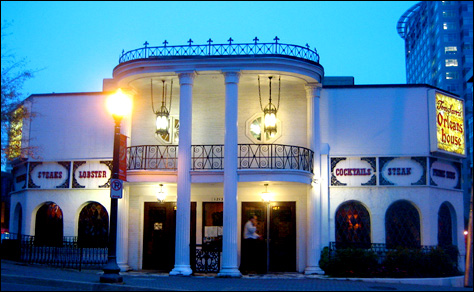
I loved the unusual décor, the riverboat salad bar, the reasonably priced prime rib and well, just about every other aspect of the restaurant. Despite some negative reviews regarding service and bland offerings, I was never disappointed during a visit and always anxiously awaited the next. I may not have been able to schedule a trip to eat there one last time, but I sure would have liked the chance to try. I was frankly pissed for days over having missed the window before I knew it even existed, but work was busy and I did not give it too much thought until the weekend arrived four days later.
With the notion of lost opportunities fresh on the mind, I took the initial steps in planning a trip to Las Vegas before September. After comparing my personal and work calendars, making some financial calculations and analyzing the flight schedules from Tallahassee Regional to McCarran International Airport, I narrowed the fifty-day window down to three quickly approaching two-day periods. I specifically wanted to visit before and avoid altogether the big Star Trek convention in August so that helped narrow the choices even more. After some additional thought, I went ahead and purchased my airline tickets from Orbitz just before 0100 on Tuesday, 15 July 2008.
The final itinerary was as follows: I leave Tallahassee (TLH) at 0705 EDT on Tuesday, 22 July 2008 via Northwest flight NW5923, change planes to flight NW172 at Memphis International (MEM) and arrive in Las Vegas (LAS) at 1035 PDT. After twenty-five hours on the ground, I leave on Wednesday at 1225 PDT on flight NW175, swing back through Memphis for BBQ dinner (and a plane change to flight NW5943) getting back home at 2159 EDT. The cost was a little more than I wanted, especially after I realized I did not have enough frequent flyer points to use them, but the trip requires only two days off work and does not necessitate a hotel or car. This part of the planning now complete, I had 7 days, 6 hours to figure out the rest.
It is 0554 EDT as I walk through the quiet parking lot toward the Tallahassee Regional Airport entrance. This is my first visit to the facility so I am amused to see for myself how small it is inside. From the front doors, you can get to the luggage claim by turning left, the ticket counter by turning right and to the gates by going forward. From my car to the gate must be no more than a ten-minute walk, not including time spent in security.
The flight from Tallahassee to Memphis onboard a Bombardier CRJ-200, my first ride in this type of aircraft, was pleasant even from Seat 11-D in a 12.5 row configuration. Waiting for the next flight in Memphis, my heart skipped a few beats when it was announced the Captain for our flight had fallen ill and his replacement was en route, ETA forty-five minutes to an hour. Although my itinerary had some room built-in for delays, this was obviously a big disappointment right off the bat.
Fortunately, no more than ten seconds after the conclusion of the delay announcement, the same airline employee came back on the intercom to say the replacement pilot had arrived and they were expecting a nominally delayed departure with boarding to begin momentarily. Soon after, I was enjoying my extremely spacious 05-A seat on the Airbus A319 segment to McCarran.
Nearing our destination, the Captain came on the intercom to alert those passengers seated starboard to look for the Grand Canyon about thirty miles out. From the other side of the jet, I was unable to see anything but was not crushed having been to the National Park previously. The Hoover Dam on the other hand was one Las Vegas attraction I did not get to visit during my 2002 vacation. This trip would be no different due to time considerations, so I was very happy to predict we would fly over or near the arch-gravity dam. The view was great even though we were on the north side and could not see the front of the dam wall. I happily took pictures until the flight attendant approached and kindly reminded me all portable electronic devices were to be off in preparation for landing, about twenty-three miles away. The woman seated next to my right, who during the entire flight perhaps said six words to me, suggested I be more stealthy next time.
Since I was traveling with literally the shirt on my back, I was able to quickly exit the plane and make my way to the taxi queue outside. Although during heavy travel periods the line can be quite long, it moved fairly quickly on this day. "The Las Vegas Hilton, please," I said to the driver and we were on our way. Looking out the window, it appears there at least five casinos under construction and countless others built since my last visit. The Las Vegas Monorail has also expanded away from The Strip, meeting up to and following Paradise Road overhead for service to the Convention Center, Hilton and Sahara.
I arrived at the Hilton ahead of schedule and before the opening of Star Trek: The Experience. I walked over to the adjacent SpaceQuest Bar killing some time enjoying a few cocktails and talking to the bartender, a nearly 60-year old man who has lived in Las Vegas his entire life and is getting ready to retire after 35 years at the Hilton. From my barstool, I had an unobstructed view of The Experience main entrance and ticket area, so when I saw the gate rise and a small line forming, I made my way over.
Purchased online for $44.99, my general admission was $5 less than the door price. The online ticket also included a $5 discount on the behind the scenes tour reducing it to $26.99. I selected the second behind the scenes tour of the day at 1430 so I had time to see the attraction first. Transaction complete, my ticket scanned and hand stamped, I proceed inside while greeted "live long and prosper" by the ticket clerk. The walkway between the main entrance and the ride queue comprises the History of the Future museum featuring costumes, props, models, artwork and a comprehensive timeline of the fictional universe. Much of this area is unchanged from my first visit, with the notable exception of items added from the short-lived prequel series Star Trek: Enterprise, which I have basically never seen. The artifacts are looked after by Curator Penny Juday, Paramount art department coordinator. Three 1/50th scale starship models built specifically for The Experience hang overhead. At the front entrance, the USS Enterprise NCC-1701 refit and a Klingon Bird of Prey greet visitors, while in the main area are the beautifully internally lit USS Enterprise NCC-1701-D and USS Voyager NCC-74656.
Before I can spend too much time looking at the artifacts, attraction crew member David Grider rushes by announcing the rides are nearly ready to load. Since I can spend as much time here as I want, I skip the museum for now and proceed to the ride queues. When I get toward the front, I see that Borg Invasion 4D has the line with fewer waiting visitors and a higher capacity per show. This ride did not exist during my original visit, opening on 18 March 2004 in response to declining sales. I select this line and in just a moment, David returns to begin the loading sequence.
After passing through a circular, blue-lit "scanning" corridor, the group enters the future and a briefing room at the Copernicus Station research facility, located near the border of the Delta Quadrant. After a brief introduction by your Starfleet officer guide—one of the many actors that play roles in the attraction—The Doctor, an Emergency Medical Hologram originally from USS Voyager, appears on the screen to welcome you aboard. He explains he is studying genetic material resistant to Borg nanoprobe technology ("Project Resistance") and believes a member of our group may be a match. However, The Doctor's extemporaneous remarks about his skill and genius are interrupted dramatically when sensors detect an unidentified vessel closing quickly at warp.
The station goes to yellow alert and the officer assures us everything is fine. Seconds later, the vessel is identified as Borg and red alert is declared. Under fire from the Borg, the station takes heavy damage despite efforts to defend itself. The lights flicker and dim, while ButtKicker subwoofer speakers built into the floor make it feel like we're really there. The Doctor instructs our officer to lead the group to safety, a shuttle we can use to escape. Borg can be seen assimilating crew in the background just before communication with The Doctor is lost and he vanishes from the screen.
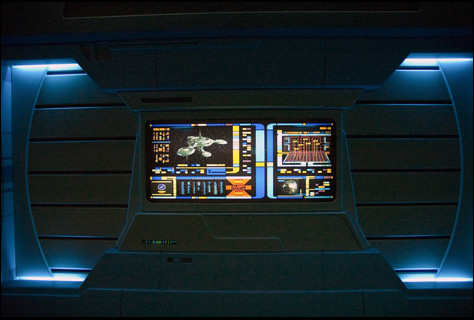
Another officer joins the group and leads us through damaged and assimilated corridors on our way to the escape shuttle. As we move along, he warns us of an approaching drone that turns out to be more interested in a computer console. After he says this Borg poses no threat, another drone captures the officer who pleads for us to run and save ourselves. At the other end of the corridor, another officer at an elevated console is trying in vain to open the door to the shuttle bay. When additional drones approach us from the corridor (live actors) and above (animatronic), the officer uses a phaser to destroy the door locking mechanism but is pulled up into the ceiling by an unseen Borg right after. The door released, the surviving officers usher the group quickly into the theatre, er, escape shuttle. After sitting, we don 3D "safety glasses" ready to make our escape. The entire corridor sequence was well acted and contained some simple, yet convincing practical effects such as lasers representing phaser beams. I was excited to see what the 3D movie had in store.
Predictably, the Borg thwart our escape. Using a cutting beam to tear open the front of the shuttle, the Borg expose the cabin to space save a force field which immediately deploys. A tractor beam locks on and pulls us into the cube where we are met by the Borg Queen, played by Star Trek: First Contact film actress Alice Krige. Appearing first as only her head, shoulders and mechanized spine, the Borg Queen joins the rest of her body while discussing her knowledge of The Doctor's anti-Borg scientific efforts. Assuring us the Borg will not allow this work to continue, the Queen sprays assimilation nanoprobes into the group.
A quick splash of water accompanies the 3D images, creating another great practical effect. While the movie shows our assimilated view from inside the collective, the Borgification process can be felt and heard thanks to speakers and moving devices built into the seat. The Queen lectures us on the perfection of the collective and commands us to surrender and join the hive. The steadicam takes us flying down Borg corridors and into a chamber where we circle around and then come to the front of an assimilated Starfleet officer who is about to have his eye replaced with an implant. As a medieval Borg tool moves toward the officer's eye, our perspective changes to his view!
It is quite a creepy experience overall and it is obvious we are about to succumb to assimilation but The Doctor interrupts, projecting himself into the collective. "You are resistant to assimilation," he exclaims. "Fight it! We're coming for you," he says before fading away. Upon seeing the group ward off the assimilation process, the incensed Queen says no one has ever resisted and prepares to take additional action when an incoming transmission interrupts, "Maybe it's time we even the sides." Screens on either side of the theatre switch on revealing Admiral Kathryn Janeway on board USS Voyager.
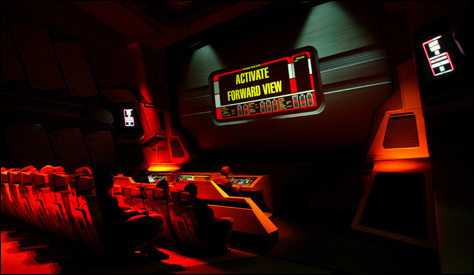
A large explosion occurs at the far side of the Borg cube central chamber and Voyager bursts through. "Stand aside, I've come to take these people home," Janeway commands to the Queen as the ship advances toward our position, crashing through support beams in the way. "You're a fool, Janeway," the Queen retorts. "Soon, this ship and everything in it will be destroyed," she continues, initiating a self-destruct sequence. Unfazed, Janeway states "don't bet on it" and Voyager opens fire on the Queen's position. Several phaser blasts fail to impact the Queen, who appears to transport away immediately before her platform is finally destroyed. Janeway and her ship are nearly to our position when they fire quantum torpedoes and lock on to us with a tractor beam, pulling the shuttle to safety. We have front row seats to the Borg cube being completely and spectacularly destroyed in a massive explosion.
Our ship is returned to the station, where already repairs are being made. Before heading off, Janeway addresses the group one last time. "Congratulations, you've defeated the Borg with the one thing the Queen can never assimilate: the human spirit. As long as we have that, resistance will never be futile." The theme from Star Trek: Voyager plays and the officer instructs the group to exit right, depositing our 3D glasses on the way to the corridor.
I thought the whole thing was very well done with an obvious attention paid to detail. The movie itself is an impressive 3D picture with quality digital effects and screens positioned above and to the sides adding to the realism. While waiting for and riding in the large 20th century elevator to the Promenade shopping area where all ride participants are funneled out, I could not help thinking I liked the original ride more, the awesomeness of Borg Invasion 4D notwithstanding.
Wasting no time, I proceeded quickly through the History of the Future museum and got in line for Klingon Encounter, originally called "the ride" or The Voyage Through Space in the days before Borg Invasion 4D. I chatted with some friendly tourists who were enjoying the Star Trek Trivia Q & A video playing on a TV next to the Borg drones watching over the queues. Before too long, we are moving into the first part of the attraction, a room where a Star Trek: The Experience promo reel is being played. After a few minutes of the video, attraction guide David tells the group we will be boarding a motion simulator ride and leads us into another room where we are instructed to form four lines and keep away from the doors in front and the walls to the sides and behind.
As a "short two-hour" safety video plays regarding the motion ride, the lights flicker and the screens go black. Suddenly, twinkling lights surround you and the transporter effect sound is heard. With a rush of air, the lights turn on revealing you to be standing on the transporter pad on the USS Enterprise NCC-1701-D. From the transporter console in front of you, Starfleet officer Lieutenant Edwards approaches and welcomes the group to the future, 2371, before asking who is in charge. David replies that he is and the officer instructs him to move off to the side to be briefed by security before asking us to follow them. Leaving the Transporter Room and turning right, the familiar curved corridor takes us to the most detailed and exciting of all the sets, the Enterprise Bridge.
Entering from what is the door to the Observation Lounge vestibule on the show, the group is kept at the rear of the Bridge, in front of the science stations and behind tactical. Ensign Thomas is at the helm while Lieutenant Edwards walks around the Bridge using different consoles and interacting with Commander Riker on the main viewscreen ahead. Ambient sound effects beeping convincingly, the plot unfolds as Riker along with Chief Engineer Geordi La Forge explain that a group of rouge Klingons led by Korath have kidnapped Captain Picard and our group from the past. It seems a member of our group is an ancestor of Picard and Korath intends to prevent Picard's existence by kidnapping both him and the ancestor. Wise to the Klingon plan, Riker and the Enterprise intercepted the transporter beam and took us aboard instead. As three Klingon Birds of Prey approach on an intercept course, Riker details our escape plan which begins with losing the Klingons in a nebula and then returning us to the temporal rift via shuttlecraft. With his order of "red alert," the lights on the Bridge dim, flash red and a klaxon sounds. This is one of those moments where you feel like you are really there, especially if you have imbibed at Quark's beforehand.
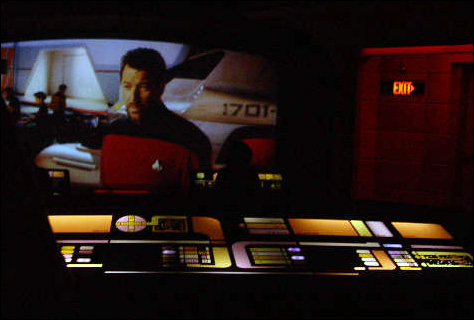
Ensign Thomas takes our group into the turbolift for a ride to the shuttle bay. From there we will board the shuttle Goddard, make our way with the help of La Forge on the shuttle Valiant to the rift and back to 2008. While in the turbolift, the Enterprise slows to impulse to enter the nebula but the Klingons catch-up and begin an attack run. While listening to the Bridge reacting, attacks damage the ship causing the turbolift to enter into a shaky, twenty-five second "free fall" before regaining control. With main power on this deck offline, we exit the turbolift and follow the red lit corridor past various cargo containers to the loading area for the shuttle and, in turn, the real motion simulator ride.
Lined up in rows like the start of the attraction, we watch a Starfleet safety training video, this time being conducted by La Forge. When the video begins, the voiceover and subtitles are in an unknown alien language. "Sorry, wrong language mode," La Forge says as the video continues in English. At one point, pregnant guests are advised not to ride. In the video, a pregnant woman having just heard this warning decides to leave the line. A man inferred to be the father and husband embraces her, but stays behind in the line determined to ride. After the video concludes, the door in front slides up to reveal the shuttle facing right, its entire starboard side opened to allow boarding.
The door closes and the ride begins, showing our position facing the shuttle bay door from inside. Since the power is still offline, the shuttle bay is decompressed pushing us out. Our pilot, Lieutenant Carson, flies us around the Enterprise careful to avoid the weapons fire and follows La Forge's shuttle, vacating the area by jumping to warp—another awesome effect. Arriving at a nearby planet, La Forge says he detects a cloaking generator and we proceed to investigate but are met by hostile Klingons who bring on a fire-fighting chase. One Klingon vessel destroyed by La Forge's tactics, we move on to the generator, destroy it together and then enter the rift. We emerge over the Las Vegas Strip, a moment that always generates a laugh from the audience, and fly to the Hilton where the Klingons surprise both shuttles and lock on tractor beams.
"It's over, humans. But take heart, today is a good day to die," Korath exclaims as it looks like he may be victorious. "If you say so, Korath," is heard spoken by Riker just as the Bird of Prey explodes in front of you. In its place swoops in the Enterprise, once again there to save the day. La Forge asks Carson if she can detect a ventilation shaft and acknowledging affirmatively, we proceed to crash through the Hilton "H" logo sign atop the hotel, flying down a shaft to a large image of Deep Space 9 and the simulators we were supposed to ride just before our abduction. The ride concludes with a voiceover from a grateful man, now back aboard his ship. "Captain Picard to Goddard, can your passengers hear me? Ladies and gentlemen, I owe you all a debt of gratitude for helping restore the timeline as well as my own existence. But please, don't tell anyone what's happened to you today. It could disrupt the future once again. While only one of you is my ancestor, each of you holds that future in your hand. Guard it well."
The theme from Star Trek: Deep Space Nine plays as the right side of the shuttle opens, revealing Ensign Thomas to be gone and in their place, our original guide David who jokes with the exiting group. As you approach the 20th century elevator in the post-show corridor, a "live" KVBC News 3 television broadcast playing overhead reports breaking news as two dozen witnesses report unidentified flying objects in the skies over downtown Las Vegas. They cut to reporter Phil Bernoff at Nellis Air Force Base where a Colonel is being inundated with questions. He claims the eyewitnesses saw a weather balloon and snidely dismisses the further questioning about reported explosions. Like the parts of the ride film where you fly over The Strip, this television segment is cool but noticeably dated. My suspension of disbelief is not in question though, so these anachronisms are of no consequence to me.
My next stop was to Quark's on the Promenade. I had very specific plans for dinner already, so I chose not to eat anything. I did want to enjoy more blue Romulan Ale and did so accordingly. However, this time I think the beer might just be Yuengling or something similar. I always assumed that because the bottles lacked any other designation, it was a micro-brew of some sort. Other selections like Budweiser and Newcastle have Trek names on the menu as well, but are nothing more than their standard product. According to information online, Paramount licensed the beer specifically for The Experience, brewed by Cerveceria La Costancia in El Salvador.
After several Romulan Ales at the bar, it was time for Star Trek: The Experience – Secrets Unveiled, the guide-led backstage tour started in 2005 (listen to a recent recording of this tour led by veteran cast member April Hebert). I made my way upstairs to the tour sign-in station under the Enterprise, which I had to lay down to photograph. Before the tour began, our friendly guide Gretchen Baker made a point to introduce herself to each of the 20 some participants and to memorize their names. She also implores the group never to push any buttons during the tour, even those that appear to be nothing more than futuristic set dressing. Many ride operations are initiated through disguised consoles, so you could accidentally start something by innocently pushing buttons around the ship. In a final illustration of her seriousness, Gretchen walked by each participant holding out a large emergency stop button and invited everyone to push it, "to get it out of your system."
Even though the small group will stay with Gretchen the entire time, wireless headsets are distributed to make it easier to hear the presentation. We begin by walking through the History of the Future museum, which by now I have been through numerous times. Gretchen explains that The Experience took great care in updating the detailed Star Trek chronology when new canon material was made. Examples of updates through the years include the conclusions of Star Trek: Deep Space Nine and Star Trek: Voyager, entries for the last two movies (Star Trek: Insurrection and Star Trek: Nemesis) and the prequel series Star Trek: Enterprise.
Opposite the timeline are the cases filled with props, uniforms and other official production materials. There are too many items to comprehensively list here, but notable items include the Macintosh Plus, Spock's robe and the uranium collector from Star Trek IV: The Voyage Home; the 2265 vintage Dom Pérignon bottle, emotion chip and Picard's family album from Star Trek Generations; one of Geordi's VISORs, numerous PADDs and combadges, the rare Kurlan naiskos artifact and various phasers from Star Trek: The Next Generation; and the Mark IV photon torpedo case used as a casket for Spock as seen in Star Trek II: The Wrath of Khan and Star Trek III: The Search for Spock. There are seat belt straps now keeping the lid closed because pranksters used to like to climb inside and jump out at unsuspecting passers by.
After moving through the museum, we proceed to our first backstage stop. Halfway down the ride queue corridor is a door on the right marked "authorized personnel only." With her key, Gretchen opens the door and we proceed inside a black-walled, gallery lit space containing conceptual drawings, engineering diagrams and floor plans for each part of The Experience. From the floor plan dated 21 October 1996 and the narration, you learn that there were originally two Klingon Encounter rides built side-by-side; two Transporter Rooms, two corridors, two Bridges, two turbolifts and two shuttles. As originally designed, The Experience required three years of design and two years of construction before opening in 1998. After a few years, sales naturally declined and it was decided to transform one of the Klingon Encounter rides into a new attraction. After eighteen months of design and eight months of construction, Borg Invasion 4D opened. While consuming most of the second Klingon Encounter, its Enterprise Bridge remained intact and was used for weddings, private events, photographs, cast auditions, interviews and training.
Continuing through the backstage corridors used by the actors to get from set to set unseen, Gretchen must frequently radio our position ("BST to base") and request clearance to continue forward so as not to interrupt one of the attractions in progress. We arrive at the Klingon Encounter "motion simulator" pre-show and loading rooms for our first big peek at the magic: the transporter effect. There are a number of factors at play that make this experience as realistic as possible. The Lexan floor is designed to look different when lit from above and below, making the transition from the dark ride queue to the bright transporter pad as easy as changing the direction and intensity of light. When the beam-up sequence begins, the darkness and shimmering lights camouflage the real transportation—that of the walls forty feet up into the ceiling. The 7,000 pound hydraulically controlled walls are pulled upward with such speed (sixty miles per hour) that the gust of wind experienced is produced naturally by the vacuum created, though was an unintentional bonus. A new ceiling then fills in the space overhead and the effect is complete.
In order to prevent injury, the guide ensures visitors are standing away from the wall before beaming them up. Standing on a sensor platform in the room which triggers a light on the Transporter Room console, the guide indicates to the transporter operator it is safe to run the special effects. Should the guide step off the sensor platform, the ride automatically stops to prevent injury. The transporter effect is a simple, yet effective technique that was, as Gretchen joked, "even better with the lights on."
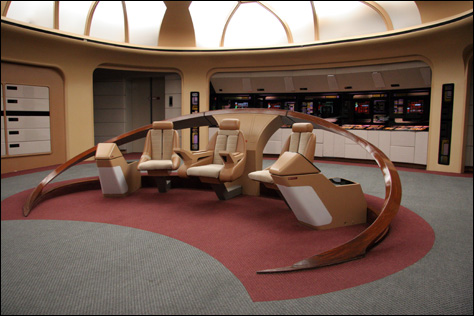
We exit the Transporter Room and move into the corridor on our way to the Bridge where, for the first time, I was able to walk around and really see the details. As Gretchen sat at the conn telling us some history of the set and stories about how the cast audition process worked, I roamed the Bridge inspecting every station and panel. Hidden in the ceiling from the view of ride visitors is a three-color projector that provides the viewscreen images. We are told that series actors who visited this Bridge complimented its accuracy and enjoyed the experience of there being a real viewscreen, walls all around and no film equipment. Walking toward the door to the Ready Room, again hidden from view of normal ride patrons, I see this door is nothing more than a stand-up piece not quite sealing the hole. Through the space I can see a Styrofoam cup and a poster of some kind backstage.
I sat in each of the command chairs and then tried out the ops station where Data worked. Much like those seen during The Next Generation's first season, The Experience conn and ops chairs are uncomfortably reclined. When I went through the attraction after this tour, I noticed the actors all sit straight instead of back because of this. The Bridge ambient audio is very realistic and provides a lot of atmosphere. Gretchen notes that interviewing actors who comment about the beeping during their audition not realizing it is part of the set are immediately disqualified. After everyone has a chance to inspect the Bridge, sit in the chairs and ask questions, it is sadly time to move on. I take one last look at the Bridge when entering the turbolift, for the next times I see it will be on the ride confined to the aft deck and then never again.
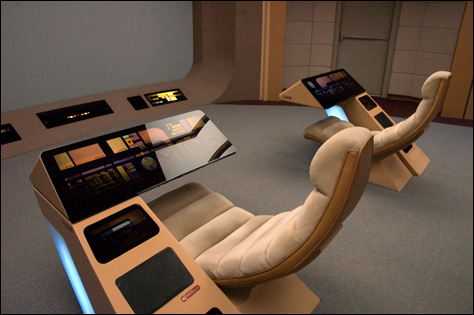
In the turbolift, we are told about the free fall effect which has another simple yet effective system of operation. The turbolift needs to rotate 160-degrees to realign the door with the motion ride corridor and away from the Bridge, so it is built atop a tank gun turret. Between added shakes and the audio/lighting effects, a true free fall experience is not felt but the rotation does help add to the disorientation. Gretchen pointed out the square access panel in the floor leading to the turret hardware. Because of the design, those standing closer to the center of the turbolift experience less turbulence than those standing along the wall, despite frequent assumptions to the contrary.
Moving from the turbolift into the corridor leading to the shuttle bay, we learn that this 50 foot space used to be twice as long when it acted as one big corridor during the time two Klingon Experience rides were in operation. As part of cost saving measures in the Borg Invasion 4D project, this space was simply halved by a new wall and the Borg side made over by painting the windows black, lowering the ceiling in parts and installing new wall panels and overhead pipes. Mirrors on the Klingon Encounter side help make the space look longer, though I remember from my first visit that it really felt like a long, winding double-high corridor and now felt more consolidated. We are told that some of the cargo containers lining the space were actually featured on TNG and that one is actually from the show Babylon 5. Now at the far end of the corridor, we wait for clearance before Gretchen moves a 24th century conduit out of the way of a pass-through to the Borgified side. We pass two "Borg-a-loungers" where Borg actors sit and cool themselves with fans—the costumes are hot and heavy—between performances and enter the corridor where the live action stunts take place during Borg Invasion 4D.
We are told how the exploding door panel takes its cue from light transmitted by the phaser prop fired at it. Apparently, it can be a little picky so the actors must practice hitting the right spot. Other markers in the corridor help actors position their prop phasers so lasers planted in the wall appear to be emanating from the weapons as phaser fire. Theatre smoke pumped into the space adds not only to the ambiance but aids the phaser/laser visual effects. For the sequence where the officer is pulled into the ceiling by a Borg drone, the actor wears a harness under their uniform. They clip the harness with a carabiner to a d-ring on the air-powered manlift. At the right moment, the manlift is activated and the actor is pulled up, whilst dramatically flailing and screaming. In the event something goes wrong, there is a hidden trip switch on the Borg arm the actor can push to abort the lift and descend immediately.
Gretchen pointed out the small inside jokes, movie lines and song lyrics printed on the hundreds of Starfleet labels found everywhere, just as was done on the television series sets. I was pleased when she asked the group if anyone could identify the pipes labeled GNDN. As I long ago adapted this term into my lexicon, I was pleased to quickly answer, "goes nowhere, does nothing." We double-back and head through the assimilated/damaged corridor housing uniformed dummy Ensign Deadman ("who is likely wearing a red shirt," Gretchen quips) to enter the Copernicus Station briefing room before continuing backstage. Down some typical hallways and though a server room, we arrive at the Klingon Encounter motion rides, this time from below.
Standing beneath the rides and in front of the large screen is an interesting perspective, especially when they turn on the rides and film for us. The vehicles do not appear to move and shake as violently as it feels when you ride. The walls down where we are look rough and coated with something. Before I could ask if it was soundproofing, Gretchen offered that she thought the same thing until learning it is just blown concrete, unfinished because no guests were going to see down here. There are twenty-two computers running at least the Klingon Experience side of the attraction, interfacing with one-another and having very little memory. The touch-screen control system for the ride is a legacy application still run in Windows 3.1. The 24th century, indeed. The domed screen provides riders a 160-degree viewing area and is sixty feet across, weighing 9,000 pounds.
Leaving the motion simulator workspace and making our way to the office area, we learn more about the history of the cast and production. The walls in these areas are covered with memorabilia from The Experience and the shows, much of it signed by actors. There are also numerous photographs from the construction of The Experience, including the exterior, interior, shuttles and starship models. Passing through the wardrobe area, we learn that the actors must apply their own makeup before performing. They are provided alien makeup classes and the prosthetics are designed to be easily used by the actor wearing them. A Borg actor has it easy, since the prosthetic head mask covers all but one eye and the neck area while an Andorian, on the other hand, must paint themselves blue from the shoulders up. Gretchen is able to speak about this with authority as she plays the Ferengi character Risca on the Promenade. We are told Risca is visiting the time station as part of a student exchange program and is studying female fashion design.
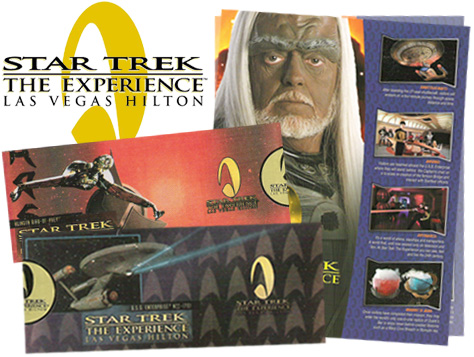
The backstage tour concludes upstairs in the Captain's Lounge private dining and event hall, built in the space above the Promenade corridor. After The Experience was a success with weddings and other private events, this space was built to accommodate, lessening the former open-air feel of the Promenade below. At this point, Gretchen opens the floor for final questions and invites us to sign the guest book. While she signs some documents and answers questions, people leave their headphones and receivers on one of the banquet tables before receiving some Secrets Unveiled goodies.
Inside a folder bearing The Experience logo is an original admission ticket from the attraction's premiere, a stash of which were discovered in storage inducing their inclusion in the parting gift, with the Enterprise from the original television series on one side and a Klingon Bird of Prey on the other. The folder also contains an older one-sheet promotional flyer featuring General Motog (Tom Deishley) and the original attraction telephone number 1-866-TREKEXP (later replaced by 1-888-GO-BOLDLY). Each participant also leaves with one final item, a personalized certificate bearing the date, tour number and signature of our "tour ambassador."
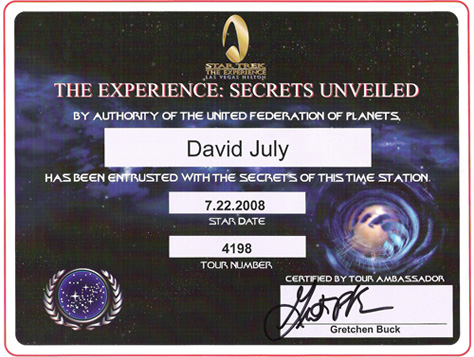
I used this time to ask more about the employee experience during this tumultuous time. Apparently, the attraction's staff was informed of the closure the same day this news was announced publicly by Cedar Fair. A commonly-held belief is that the contract negotiations broke down due to the Hilton's desire to re-purpose the space for some other, more profiteering venture, or accept an exorbitantly increased rental fee for things to stay put. No matter the final reason for the closure, you can tell the family of staff made up of actors, co-workers and fans alike are extraordinarily saddened and not only because it means their unemployment.
Upon hearing the announcement, several employees left in search of other jobs afraid that if they waited until the end they would endure a period of unemployment. Those that stay behind do so out of loyalty and throw caution to the wind so they may participate in the last month of operation. After the last ride at 2000 PST on 01 September, guests will be invited to gather in the SpaceQuest casino area just outside The Experience for a naval-style decommissioning ceremony conducted by a special guest host and Chad Boutte, Operations Manager/Marketing Director, concluding with each cast member walking off the station. At 2200, a private engagement will take place at Quark's with the staff, friends and family, some special guests and a group of people who each won an auction for the attraction's last tickets and performance.
Gretchen had hoped the special guest for the last day would be Jonathan Frakes, with whom the cast felt a familiarity after "interacting" with him as Commander Riker on the Bridge for years. Suzie Plakson who has appeared in guest roles such as K'Ehleyr and Dr. Selar was instead on-hand for the ceremony with Boutte.
I head downstairs to Quark's after wishing Gretchen well and enjoy one last beverage at the resident bar. After a few more trips through the two attractions, during which I got to see Gretchen perform on the Bridge as Lieutenant Edwards, I walk to the wheelchair-accessible ramp on the right near the exit and look at the Wall of Memories. There is a podium with construction paper, markers and a framed sign that says the following.
Wall of MemoriesThe staff of Star Trek the Experience would like to extend out heartfelt thanks to all of our dedicated fans who have made the last ten years the most phenomenal experience that anyone could ever imagine. We encourage you to share your thoughts and memories of us through notes, photos, and items to be placed on this wall. Please place your note, or item in the wall file and one of our associates will adhere it to the wall for you. Thanks for your visit, and assisting us with creating memories that will last a lifetime.
Please note: No personal information i.e. phone numbers, e-mails, or addresses will be displayed. Also, these items will not be returned.
After writing my own note and neglecting to photograph it, I read some of the other messages and purchase an official backstage tour T-shirt, available to tour participants at 10% off. I thank the cashier and look around as I walk to the exit, up the stairs and out of The Experience, heading left down the corridor to the hotel's north tower exit. As I emerge into the warmth and light, I am happy to have taken the time and money to make this trip, because it was absolutely worth it.
Thanks to the magic of the internet, my message on the Wall of Memories is visible in this photograph and in Part 4 of this video tour (includes the Klingon Encounter ride), both by people visiting weeks after me. My note says: "I am glad I was able to come back one last time before the unfortunate conclusion of Star Trek: The Experience. To all that have made it a wonderful escape for these years – thank you!"
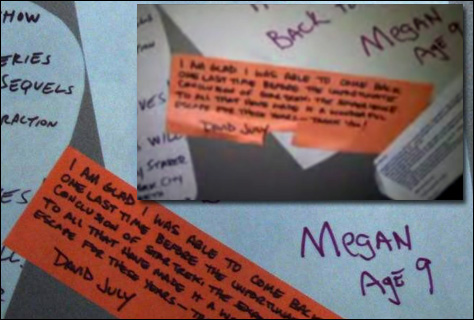
My primary mission complete, it was time to move on to my dinner plans at Marie Callender's. While researching this trip, I was floored to find a location just one mile from the Hilton. I feel both the dry desert heat (the day's high was 105° F) and the lingering humidity from the storms that blew through just days prior flooding portions of the region. The twelve-minute walk is not uncomfortable, but I am very happy regardless when I round Sherwood Street and see the 600 East Sahara Avenue eatery sitting exactly as Google Maps Street View showed.
My meal, the meatloaf dinner and brown gravy with mashed potatoes, green beans and garlic toast was excellent, as was the service of Donald who helped me purchase a gift for Mom. When I asked what I could bring her back, she requested Marie Callender's corn bread mix. Donald had to check if they had any available, but when he returned to the table he did not do so empty-handed. I had the option between one-pound and five-pound bags. Throwing caution to the wind and realizing I was probably stuck carrying my purchase the rest of the trip since the shipping location I had identified was closed by now, I bought one five-pound bag. I slowly finished my meal, enjoying every moment of air conditioning before re-entering the oven outdoors. My itinerary, like a Choose Your Own Adventure book, had some room for on-site negotiation and I was now upon the first fork in the road. Already this far north, I could visit the old downtown, Fremont Street and see some signs restored from the Neon Boneyard. Not wanting to get a cab and somewhat disinterested in making the trip on foot, I voted to skip the jaunt north and instead begin moving south toward the third and final mandatory destination.
Following the original plan to ship purchases home from The UPS Store at the Flamingo, I walked from Marie Callender's west on East Sahara Avenue to the Las Vegas Monorail Sahara Station on Paradise Road. The all-day pass available online for $9 can take fifteen days to arrive so that was off the table during the planning stages. Since I only planned to use the monorail this one time—it is only open until 0200 on Tuesdays—I decided to purchase a $5 one-trip pass at the station. The three mile trip to the Flamingo/Caesar's Palace Station past the Las Vegas Hilton, Las Vegas Convention Center and Harrah's/Imperial Palace Stations seemed to pass quickly. My shipping plan would have worked flawlessly had the store stayed open past 1900 because you have to pass it walking from the Monorail to the casino and beyond. Walking past the closed store with the corn bread mix in hand, I briskly proceeded through the casino to the street. Even for a Tuesday in July, there were large groups of slow moving people and oblivious or intoxicated tourists everywhere. The heat was tiring me faster than anticipated, so I made my way down The Strip as quickly as possible, stopping only at the Bellagio to watch the fountains and the MGM Grand to see the lions. Sadly, I ended up missing the lions who leave public view at 2200 on account of it taking me nearly an hour to walk the mile from East Flamingo Road to East Tropicana Avenue. It was simply that busy.
It would take me only twenty-five minutes to walk the next mile south from Tropicana past the last casinos and into the dark of the night, as much as that is possible so close to the capital of second chances. It was an interesting sensation to go from being around thousands of people to none inside the space of an hour. Shortly after crossing West Russell Road and moving between the Bali Hai Golf Club and McCarran, I can see the last stop. I wait a moment for a lull in traffic and then run across the road to the center median. Before me stands the world-famous Welcome to Fabulous Las Vegas Sign (1956). I have the sign to myself and take a number of pictures before heading back toward civilization.
It has been hours since my last alcoholic beverage at the Hilton, yet I am incredibly dehydrated. I stop at a gas station just south of Tropicana at East Reno Avenue to purchase several bottles of water. I drink one of these before leaving the parking lot. All I really want to do it sit for a few minutes and put the bag of corn bread mix down, but there are no benches in Las Vegas. At all. The only ones I found were bus stops and they were fairly uncomfortable. Not interested in hanging out in a casino, the obvious goal behind the benchlessness, I join a woman at a bus stop next to the gas station. I sit for a few minutes but it is not particularly comfortable, so I wish the woman well and continue on my way.
The next best thing I could find offered the environment I desired but not the seating. In a compromise, I sprawled out on a deserted and infrequently traveled sidewalk in front of the Tropicana. From here, I had excellent views of the MGM Grand, New York-New York, Excalibur, Luxor and Mandalay Bay. After about an hour, the concrete won the ongoing battle with my body and I resumed on foot. Tired and content calling a full lid to my extremely successful day trip, I started on foot toward the airport terminal. Once I remembered the entrance was on the other side of the facility and the walk likely treacherous and sidewalk-free, I went back toward a Motel 6 on Tropicana thinking they must have a bench.
I settled for a rock wall in front of the office for a while before getting curious and wandering inside. When I approached the clerk and asked the cost of a room for the night, I was prepared to accept any price under $100 for a chance to shower and sit down so am surprised when he says $39.99 plus tax. "Forty dollars? Sold," I replied. I did not expect the room to be much, but it was exactly what I needed: clean, comfortable, cold and quiet. It was hard to believe this place was only one block off The Strip and right next to the airport. I enjoyed the air conditioning, lying in bed watching Hurricane Dolly make landfall in Texas before drifting to sleep.
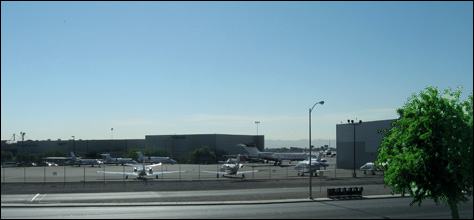
The next day rather than get out early and attempt to do something else, I stayed at the motel until it was time to check out and taxi to the airport. Standing on the balcony, I looked over toward the airport and enjoyed the warm day, briefly chatting with a motel guest next door who came outside to smoke. Leaving myself plenty of time for any delaying security procedures—the Transportation Security Administration website identified this airport as one with new advanced screening and harassment technologies—I checked out of Room 313 and asked the clerk to telephone a cab. Minutes later I was riding back to the airport, explaining to the cabbie why I had no luggage. "Now that's the way to travel," she said.
The segment from Las Vegas to Memphis was unmemorable. While walking the fifteen miles between my gates at Memphis International, I kept an earlier promise to myself and stopped at a BBQ restaurant. Close to my departure gate was Interstate Bar-B-Que (near Gate B14), which not only smelled good but also offered an efficient take-away line for those on the go. I ordered the chopped pork dinner with coleslaw, baked beans and bread. The food was excellent and they served more than I could finish. At $9.25 plus tax, this meal would be a bargain anywhere, let alone an airport. BBQ fans passing through Memphis should take notice of this eatery, a local favorite with nationwide press and recognition.
The remaining flight was also uneventful, though I did have a most enjoyable conversation with the woman from Tallahassee seated next to me. We chatted about any number of topics and before too long we were close enough to identify landmarks like Doak Campbell Stadium, Four Points and the Capitol Building. After landing, I quickly passed through the mostly deserted airport to my car, paid the $20 parking fee and drove home. Sitting in my living room about fifteen minutes later, it feels like the trip was a dream. I wonder where I'll find myself next.
Photo Credit: Paramount Pictures, WCPX TV
Photo Credit: David July
Photo Credit: M.V. Jantzen
Photo Credit: David July
Photo Credit: David July
Photo Credit: Kreg Steppe
Photo Credit: Paramount Pictures
Photo Credit: David July
Photo Credit: Ed Dravecky
Photo Credit: David July
Photo Credit: David July
Photo Credit: Jimmy James
Photo Credit: Kreg Steppe
Photo Credit: David July, Star Trek: The Experience
Photo Credit: David July, Star Trek: The Experience
Photo Credit: Auri Rahimzadeh, KevinR38
Photo Credit: David July
Photo Credit: David July
Photo Credit: David July
Photo Credit: David July
Photo Credit: David July








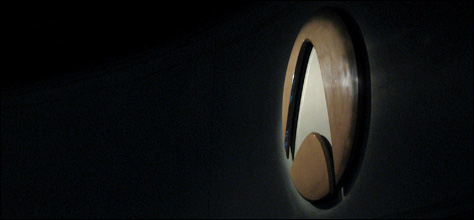
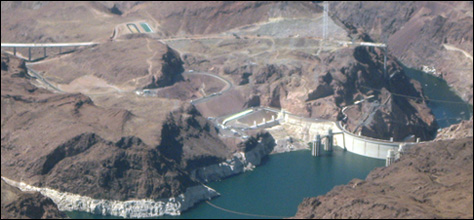
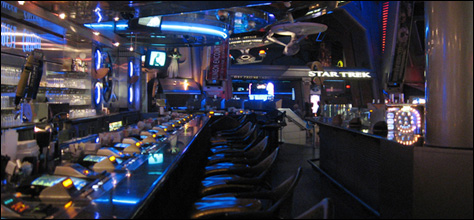
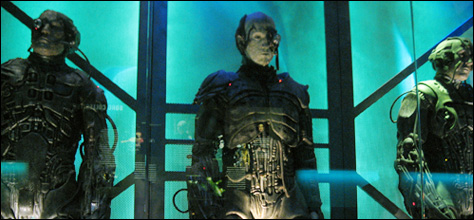
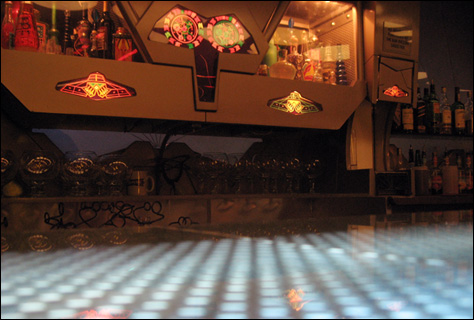
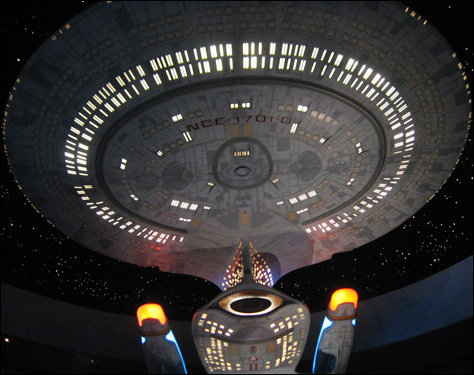
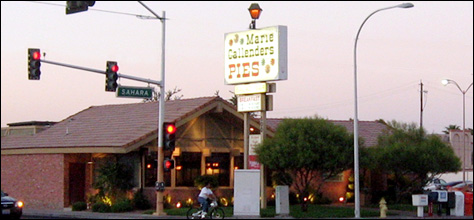

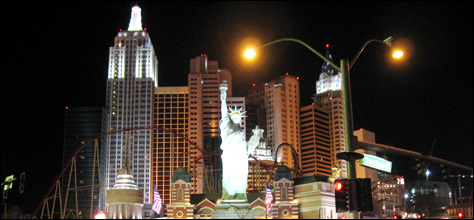
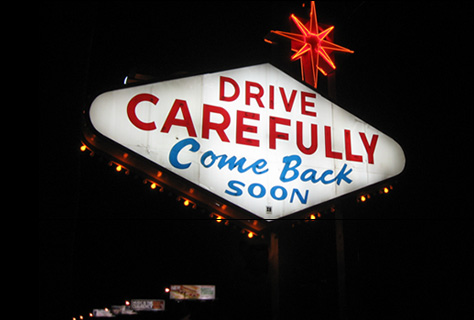
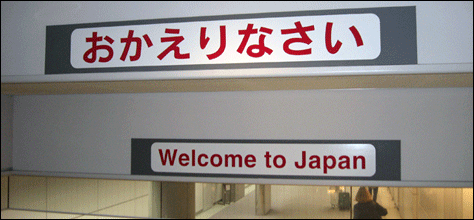
 , Japan
, Japan  to visit my friend Steven
to visit my friend Steven  and tour the area. Each day of this adventure is documented along with photographs and select Japanese translations. Select a day below to get started and then enjoy the photographs in the Gallery.
and tour the area. Each day of this adventure is documented along with photographs and select Japanese translations. Select a day below to get started and then enjoy the photographs in the Gallery.
 presents
presents
 [
[ 
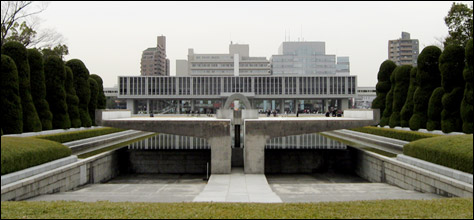 There was no time to snooze, roll over or generally be slow to rise today. Even my unconscious brain registered this fact. When the alarm sounded early this morning, Tuesday, 18 March 2008, I proceeded to prepare for my day though a daze of sorts, but as quickly and quietly as possible. Showered, dressed and with my backpack ready, I grabbed my shoes from the pile of footwear at the door and moved outside. Sitting on the staircase in darkness, I put on my shoes while an unusual quietness fills the air, accompanied only by a cool breeze.
The walk from the apartment to the subway station was equally calm and quiet. There are few people on the streets of Sagamigaoka
There was no time to snooze, roll over or generally be slow to rise today. Even my unconscious brain registered this fact. When the alarm sounded early this morning, Tuesday, 18 March 2008, I proceeded to prepare for my day though a daze of sorts, but as quickly and quietly as possible. Showered, dressed and with my backpack ready, I grabbed my shoes from the pile of footwear at the door and moved outside. Sitting on the staircase in darkness, I put on my shoes while an unusual quietness fills the air, accompanied only by a cool breeze.
The walk from the apartment to the subway station was equally calm and quiet. There are few people on the streets of Sagamigaoka  , some walking and others biking. An occasional vehicle passes and while others can be heard in the nearby distance. We move quickly and quietly, motivated by our strict timetable and the cool 50° F (10° C) temperatures, but are well ahead of schedule as we round the corner from the alley, approach the station and ascend the south entrance escalator.
, some walking and others biking. An occasional vehicle passes and while others can be heard in the nearby distance. We move quickly and quietly, motivated by our strict timetable and the cool 50° F (10° C) temperatures, but are well ahead of schedule as we round the corner from the alley, approach the station and ascend the south entrance escalator.
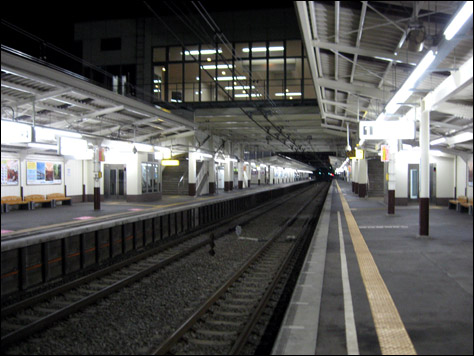 It is 0434 JST when I take my first picture of the day—the deserted
It is 0434 JST when I take my first picture of the day—the deserted  . Waiting on the westbound platform, I think about the mission we are about to embark upon. The first leg from here to
. Waiting on the westbound platform, I think about the mission we are about to embark upon. The first leg from here to  connecting to
connecting to  is a familiar one, using the
is a familiar one, using the  and
and  systems. The second short leg will connect us to
systems. The second short leg will connect us to  to begin leg three, a 494-mile (796-kilometre) journey west to the city of waters,
to begin leg three, a 494-mile (796-kilometre) journey west to the city of waters,  , Japan
, Japan  by JR, available for tourists and purchasable outside of Japan only. We did not fully appreciate it at the time we acquired them, but the Japan Rail Pass was one of the best investments we could have made.
by JR, available for tourists and purchasable outside of Japan only. We did not fully appreciate it at the time we acquired them, but the Japan Rail Pass was one of the best investments we could have made.
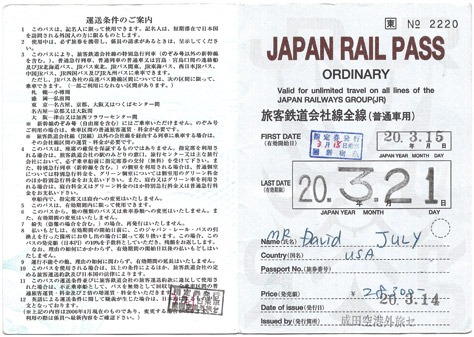 At ¥28,300 JPY (~$283 USD) each, the Japan Rail Pass granted us unlimited use of just about every JR train and bus service for seven days, with the notable exception of the
At ¥28,300 JPY (~$283 USD) each, the Japan Rail Pass granted us unlimited use of just about every JR train and bus service for seven days, with the notable exception of the 
 . While originally selected as the most cost-effective and speedy method of visiting Hiroshima in one day, the free use of the JR system proved invaluable during the entire course of the vacation. While using other train systems that did require additional payment was necessary on a daily basis, we were in many cases able to find alternate JR routes, furthering the value of the pass.
. While originally selected as the most cost-effective and speedy method of visiting Hiroshima in one day, the free use of the JR system proved invaluable during the entire course of the vacation. While using other train systems that did require additional payment was necessary on a daily basis, we were in many cases able to find alternate JR routes, furthering the value of the pass.
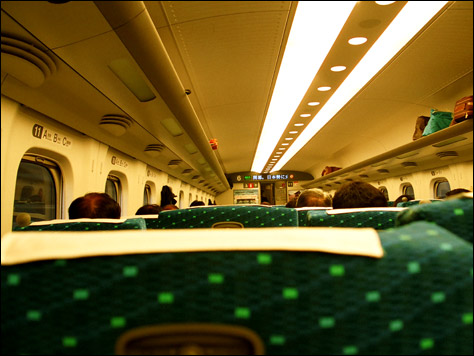 Before I knew it, I was aboard the 0615 JST
Before I knew it, I was aboard the 0615 JST 
 393 bound for Hiroshima. From seat 13-A aboard Car 6, I watched the sunrise over the Japanese countryside and got my first glimpse at living outside the megalopolis. We are on board an
393 bound for Hiroshima. From seat 13-A aboard Car 6, I watched the sunrise over the Japanese countryside and got my first glimpse at living outside the megalopolis. We are on board an 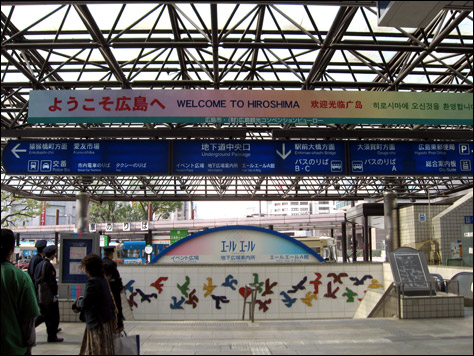 Our arrival was scheduled for 1001 JST and as is custom, we actually arrived a few minutes early. Navigating
Our arrival was scheduled for 1001 JST and as is custom, we actually arrived a few minutes early. Navigating  , we found ourselves at an information desk where the staff recommended transit via the
, we found ourselves at an information desk where the staff recommended transit via the  streetcar system,
streetcar system,  ,
,  . Moving toward the streetcars, we find no customary fare machines and watch as scores of people get on without paying. The Route 6 streetcar departing at any moment, I decided we were smart enough to wing it and hopped aboard.
The older-looking streetcar is fairly crowded as it moves along the busy and modern city streets of downtown Hiroshima. Using the handle overhead to keep my balance standing, I try to inch gradually closer to the front of the car to try to figure out how exactly we pay the fare. After a few stops, I am finally able to see people paying at a device next to the driver similar to those found on city busses. I knew from the information booth that our ride would cost ¥150 but we had only larger bills and needed change. Despite our every effort to be quick as not to delay the passengers, it took us a minute to understand how the machine makes change. Quickly detecting our ignorance, the driver assisted by inserting the money into the correct slot, collecting the fare and handing back the change. Mom maintains he flashed us a look as to say "stupid tourist." If true, this was a rare example in a country filled with extremely polite and helpful people. After exiting the streetcar, we made our way from the small platform in the middle of the street to the
. Moving toward the streetcars, we find no customary fare machines and watch as scores of people get on without paying. The Route 6 streetcar departing at any moment, I decided we were smart enough to wing it and hopped aboard.
The older-looking streetcar is fairly crowded as it moves along the busy and modern city streets of downtown Hiroshima. Using the handle overhead to keep my balance standing, I try to inch gradually closer to the front of the car to try to figure out how exactly we pay the fare. After a few stops, I am finally able to see people paying at a device next to the driver similar to those found on city busses. I knew from the information booth that our ride would cost ¥150 but we had only larger bills and needed change. Despite our every effort to be quick as not to delay the passengers, it took us a minute to understand how the machine makes change. Quickly detecting our ignorance, the driver assisted by inserting the money into the correct slot, collecting the fare and handing back the change. Mom maintains he flashed us a look as to say "stupid tourist." If true, this was a rare example in a country filled with extremely polite and helpful people. After exiting the streetcar, we made our way from the small platform in the middle of the street to the  .
.
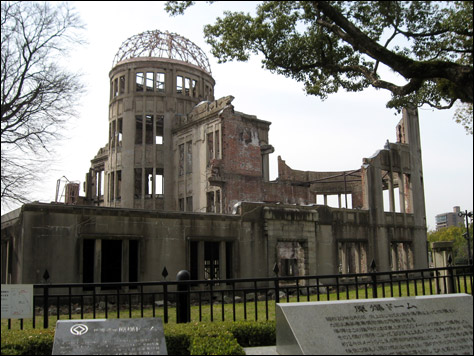 Also known as the Hiroshima Peace Memorial and commonly called the A-Bomb Dome, the 1915 structure was one of the few not completely destroyed by the bomb. Originally the Hiroshima Prefectural Commercial Exhibition Hall
Also known as the Hiroshima Peace Memorial and commonly called the A-Bomb Dome, the 1915 structure was one of the few not completely destroyed by the bomb. Originally the Hiroshima Prefectural Commercial Exhibition Hall  , the building was renamed to the Hiroshima Prefectural Products Exhibition Hall
, the building was renamed to the Hiroshima Prefectural Products Exhibition Hall  in 1921. During this time, the structure was used to display and sell prefectural products, house market research and small business consultation offices and serve as venue for art exhibitions, fairs and various cultural events. Later becoming the Hiroshima Prefectural Industrial Promotion Hall
in 1921. During this time, the structure was used to display and sell prefectural products, house market research and small business consultation offices and serve as venue for art exhibitions, fairs and various cultural events. Later becoming the Hiroshima Prefectural Industrial Promotion Hall  in 1933, the building would soon serve new purposes as promotional activities dwindled during the war. By April 1944, the building was home to the Interior Ministry Chugoku-Shikoku Public Works Office
in 1933, the building would soon serve new purposes as promotional activities dwindled during the war. By April 1944, the building was home to the Interior Ministry Chugoku-Shikoku Public Works Office  , the Hiroshima District Lumber Control Corporation
, the Hiroshima District Lumber Control Corporation  and other government offices.
and other government offices.
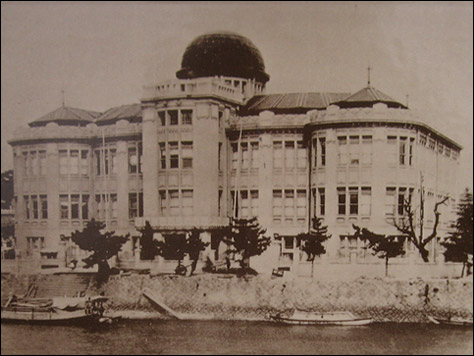 After the detonation of the
After the detonation of the  uranium bomb at 0815 JST, Monday, 06 August 1945, approximately 1,969 feet (600 metres) above and 525 feet (160 metres) to the southeast of the Dome, the building's occupants were instantly killed, the structure itself gutted by fire. Due to the direction of the blast and the physics at work, the walls and still-recognizable dome remained standing. In 1960, sixteen-year-old
uranium bomb at 0815 JST, Monday, 06 August 1945, approximately 1,969 feet (600 metres) above and 525 feet (160 metres) to the southeast of the Dome, the building's occupants were instantly killed, the structure itself gutted by fire. Due to the direction of the blast and the physics at work, the walls and still-recognizable dome remained standing. In 1960, sixteen-year-old  died of leukemia, exposed to the bomb 0.75 miles (1,250 metres) from the hypocentre at age one. After reading an excerpt from her diary which basically said, "I think only that ravaged Industrial Promotion Hall (A-bomb Dome) will be there to tell the world how fearsome atomic bombs are," the children of the Hiroshima Paper Crane Club, compelled to act on her behalf, started what became the Dome preservation movement. Their 1960 flyer containing Hiroko's quote helped the growing campaign and by 1966, the
died of leukemia, exposed to the bomb 0.75 miles (1,250 metres) from the hypocentre at age one. After reading an excerpt from her diary which basically said, "I think only that ravaged Industrial Promotion Hall (A-bomb Dome) will be there to tell the world how fearsome atomic bombs are," the children of the Hiroshima Paper Crane Club, compelled to act on her behalf, started what became the Dome preservation movement. Their 1960 flyer containing Hiroko's quote helped the growing campaign and by 1966, the  by the
by the  as a "stark and powerful symbol of the most destructive force ever created by humankind" and "the hope for world peace and the ultimate elimination of all nuclear weapons."
as a "stark and powerful symbol of the most destructive force ever created by humankind" and "the hope for world peace and the ultimate elimination of all nuclear weapons."
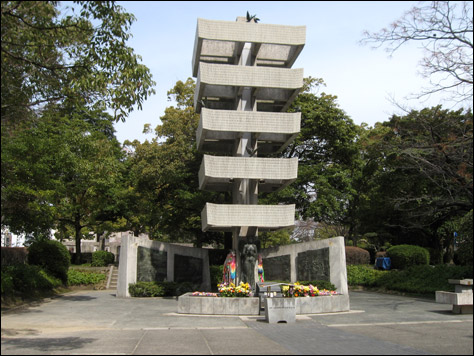 Walking south toward the Dome, the lush green and metropolitan surroundings are a strange contrast to the gutted structure, looking still as it did that Monday morning not so long ago. I silently walk around, photographing and taking it all in, as they say. Moving from the Dome and surrounding monuments, I come to the
Walking south toward the Dome, the lush green and metropolitan surroundings are a strange contrast to the gutted structure, looking still as it did that Monday morning not so long ago. I silently walk around, photographing and taking it all in, as they say. Moving from the Dome and surrounding monuments, I come to the  , completed 15 July 1967 to recognize the children forced by law to perform labor service who subsequently died in the bombing. Of the 8,400 middle school aged and older students in Hiroshima, 6,300 or 75% of them perished.
Crossing the
, completed 15 July 1967 to recognize the children forced by law to perform labor service who subsequently died in the bombing. Of the 8,400 middle school aged and older students in Hiroshima, 6,300 or 75% of them perished.
Crossing the  , we move into the main portion of
, we move into the main portion of  , encompassing 1.3 million square feet (122,100 square metres) of green parkland between the Honkawa
, encompassing 1.3 million square feet (122,100 square metres) of green parkland between the Honkawa  and Motoyasu
and Motoyasu  Rivers. After walking north to take pictures of the Dome from across the Motoyasu River, I moved south through the large collection of monuments and other remembrances starting with the
Rivers. After walking north to take pictures of the Dome from across the Motoyasu River, I moved south through the large collection of monuments and other remembrances starting with the  . Completed 28 October 1967, this unusually designed clock tower of 66 feet (20 metres) chimes daily at 0815 as a "prayer for perpetual peace and appeal to the peoples of the world that the wish be answered promptly."
. Completed 28 October 1967, this unusually designed clock tower of 66 feet (20 metres) chimes daily at 0815 as a "prayer for perpetual peace and appeal to the peoples of the world that the wish be answered promptly."
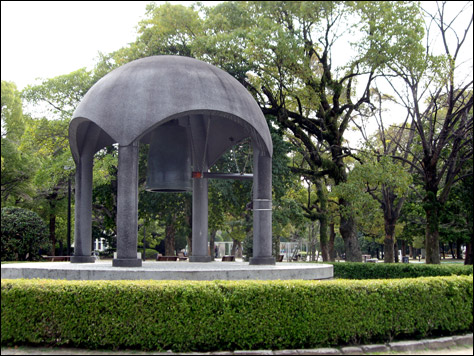 Next, I came to the
Next, I came to the  , dedicated 20 September 1964 "as a symbol of Hiroshima aspiration: let all nuclear arms and wars be gone and the nations live in true peace." Since all with the desire for peace are invited to chime the bell, I walked up, grabbed the hanging mallet and tolled. The muted but resonant sound was not very loud, but I was striking softly as instructed. In fact, my first attempt failed when the mallet had insufficient momentum to make contact with the bell's surface. I pulled back a little further on the second try and succeeded. While researching this article, I had occasion to watch many videos of Hiroshima visitors, all of whom had to try twice to ring the bell. I wonder if the mallet's rope is wound tight on purpose to help prevent excessive wear.
Continuing through the park, I next arrived at the
, dedicated 20 September 1964 "as a symbol of Hiroshima aspiration: let all nuclear arms and wars be gone and the nations live in true peace." Since all with the desire for peace are invited to chime the bell, I walked up, grabbed the hanging mallet and tolled. The muted but resonant sound was not very loud, but I was striking softly as instructed. In fact, my first attempt failed when the mallet had insufficient momentum to make contact with the bell's surface. I pulled back a little further on the second try and succeeded. While researching this article, I had occasion to watch many videos of Hiroshima visitors, all of whom had to try twice to ring the bell. I wonder if the mallet's rope is wound tight on purpose to help prevent excessive wear.
Continuing through the park, I next arrived at the  . Unveiled on 05 May 1958 as a monument to the children, the memorial itself was inspired by the death of twelve-year-old
. Unveiled on 05 May 1958 as a monument to the children, the memorial itself was inspired by the death of twelve-year-old  whose classmates began the call for such a monument. Paper cranes are continuously made and donated for display in the cases surrounding the three-legged monument pedestal, atop which stands the bronze figure of a girl holding a crane.
whose classmates began the call for such a monument. Paper cranes are continuously made and donated for display in the cases surrounding the three-legged monument pedestal, atop which stands the bronze figure of a girl holding a crane.
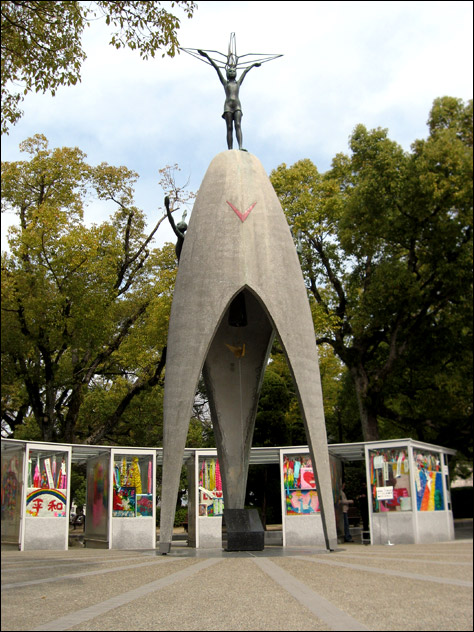 Backtracking a bit to catch the rest of the monuments on the northern side of the park, I reach the
Backtracking a bit to catch the rest of the monuments on the northern side of the park, I reach the  . After taking a few pictures, I find the sign and learn that this monument was the original site where deceased victims were gathered and cremated. The Hiroshima Memorial Service Association built the original cinerarium here in January 1946, which was later replaced by the City of Hiroshima in July 1955 by the current cinerarium and monument.
The next remembrance I came upon is the
. After taking a few pictures, I find the sign and learn that this monument was the original site where deceased victims were gathered and cremated. The Hiroshima Memorial Service Association built the original cinerarium here in January 1946, which was later replaced by the City of Hiroshima in July 1955 by the current cinerarium and monument.
The next remembrance I came upon is the  (06 August 1956), recognizing the former Nakajima
(06 August 1956), recognizing the former Nakajima  neighborhood, the present-day site of the Peace Park and preserved only in memory and detailed maps reconstructed by survivors. After the
neighborhood, the present-day site of the Peace Park and preserved only in memory and detailed maps reconstructed by survivors. After the  (10 April 1970), I moved toward the open, central part of the park and approached the
(10 April 1970), I moved toward the open, central part of the park and approached the  (Memorial Monument for Hiroshima, City of Peace)
(Memorial Monument for Hiroshima, City of Peace)  .
Built on 06 August 1952 with the desire to reconstruct Hiroshima as an enduring city of peace, the Cenotaph is constructed such that through it to the north can be seen the
.
Built on 06 August 1952 with the desire to reconstruct Hiroshima as an enduring city of peace, the Cenotaph is constructed such that through it to the north can be seen the  (01 August 1964) and Atomic Bomb Dome. The stone chest inside contains the official registry of all those who died as a result of the bombing, a figure of 221,893 as of 06 August 2001.
(01 August 1964) and Atomic Bomb Dome. The stone chest inside contains the official registry of all those who died as a result of the bombing, a figure of 221,893 as of 06 August 2001.
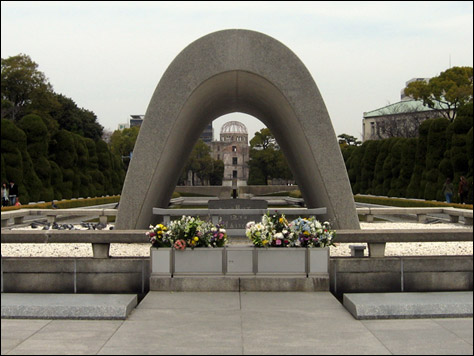 While observing the memorial, a man dressed in an all-white robe and
While observing the memorial, a man dressed in an all-white robe and  wooden sandals took position immediately in front of the Cenotaph and did what looked like
wooden sandals took position immediately in front of the Cenotaph and did what looked like  prayers due to their similarity to the rituals I observed a few days earlier at the
prayers due to their similarity to the rituals I observed a few days earlier at the  and
and  Shrines. After a moment, he assumed a military-style salute position and stood tall for a few minutes before gathering his belongings and leaving. We meanwhile explored the rest of the grounds nearby including the
Shrines. After a moment, he assumed a military-style salute position and stood tall for a few minutes before gathering his belongings and leaving. We meanwhile explored the rest of the grounds nearby including the  (August 1955) which we would later enter, the
(August 1955) which we would later enter, the  (05 September 1960) and the recently added
(05 September 1960) and the recently added  (30 July 2005).
Before heading back and visiting the museum, we frankly needed a break from the memorial and decided to see more of modern Hiroshima. Walking through the nearby neighborhoods, I found Hiroshima indistinguishable from any other Japanese city, crowded and bustling with life. No exception was the
(30 July 2005).
Before heading back and visiting the museum, we frankly needed a break from the memorial and decided to see more of modern Hiroshima. Walking through the nearby neighborhoods, I found Hiroshima indistinguishable from any other Japanese city, crowded and bustling with life. No exception was the  , which provided the opportunity to try some non-Japanese Japanese food.
, which provided the opportunity to try some non-Japanese Japanese food.
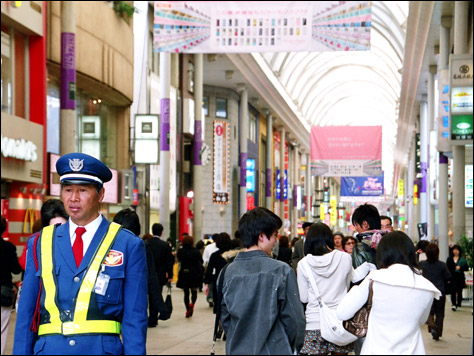 I had seen the signs for
I had seen the signs for  earlier on
earlier on  and elsewhere, but it was not until I saw the huge banner of a cheesy burger at the Hondori location did I understand what they sold. A Japanese burger, now how could I resist? I ordered the Cheese Straight Burger
and elsewhere, but it was not until I saw the huge banner of a cheesy burger at the Hondori location did I understand what they sold. A Japanese burger, now how could I resist? I ordered the Cheese Straight Burger  Set with French Fried Potato
Set with French Fried Potato  and a fountain drink. It was a tasty burger, too, similar but somehow different from a typical American fast food burger. And the fries, much like those I sampled the day before are distinctly different. I am not sure if it is the oil they are fried in or some other factor, but I really came to enjoy the crispier, slightly thicker-shelled and definitely less greasy version.
After lunch and some more walking around, it was time to return to the Hiroshima Peace Memorial Museum and tour the inside. The museum is comprehensive and contains many exhibits and artifacts, including a wristwatch stopped at 0815 by the force of the blast, a child's tricycle and metal helmet and a section of warped
and a fountain drink. It was a tasty burger, too, similar but somehow different from a typical American fast food burger. And the fries, much like those I sampled the day before are distinctly different. I am not sure if it is the oil they are fried in or some other factor, but I really came to enjoy the crispier, slightly thicker-shelled and definitely less greasy version.
After lunch and some more walking around, it was time to return to the Hiroshima Peace Memorial Museum and tour the inside. The museum is comprehensive and contains many exhibits and artifacts, including a wristwatch stopped at 0815 by the force of the blast, a child's tricycle and metal helmet and a section of warped  girder. While obviously discussing a serious and somber event, the material was presented in an informative and unbiased way I felt represented all sides and kept to the facts.
Some two hours later, we exited the museum and made our way to the
girder. While obviously discussing a serious and somber event, the material was presented in an informative and unbiased way I felt represented all sides and kept to the facts.
Some two hours later, we exited the museum and made our way to the  (2002), containing the
(2002), containing the  and resources like the victim name and photograph database and a vast library of memoirs and stories from the time and reflections thereafter.
It was now after 1700 JST, so we made a final pass through the park and stopped at the Aioi Bridge. I earlier learned in the museum that this unique T-shaped bridge was the designated target of the atomic bomb, though it missed by 984 feet (300 metres) and exploded over
and resources like the victim name and photograph database and a vast library of memoirs and stories from the time and reflections thereafter.
It was now after 1700 JST, so we made a final pass through the park and stopped at the Aioi Bridge. I earlier learned in the museum that this unique T-shaped bridge was the designated target of the atomic bomb, though it missed by 984 feet (300 metres) and exploded over  instead. This bridge, replacing the repaired original in 1983, stands as a kind of crow's nest from which you can look out in all directions and see the results of the past, the monuments to the lost and the progress forward already made in rebuilding Hiroshima into a vibrant, pleasant city.
instead. This bridge, replacing the repaired original in 1983, stands as a kind of crow's nest from which you can look out in all directions and see the results of the past, the monuments to the lost and the progress forward already made in rebuilding Hiroshima into a vibrant, pleasant city.
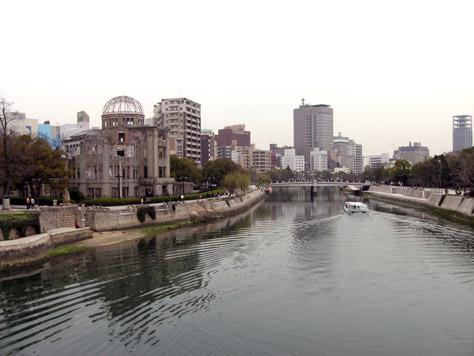 We walk to the same Hiroden streetcar stop we arrived at seven hours ago and get on the next Hiroshima Station-bound car that comes by, this time with a full understanding of how this unique transportation system works and exact change in hand. Waiting at Track 14 for the Tokaido Shinkansen Hikari 478 Rail Star to
We walk to the same Hiroden streetcar stop we arrived at seven hours ago and get on the next Hiroshima Station-bound car that comes by, this time with a full understanding of how this unique transportation system works and exact change in hand. Waiting at Track 14 for the Tokaido Shinkansen Hikari 478 Rail Star to  , the first leg in our long journey back to the apartment, we have been up for over fifteen hours. Although exhausted from the days of walking, I am surprised not to be as tired as expected.
, the first leg in our long journey back to the apartment, we have been up for over fifteen hours. Although exhausted from the days of walking, I am surprised not to be as tired as expected.
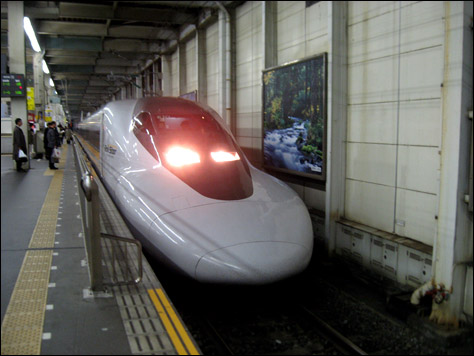 As the
As the 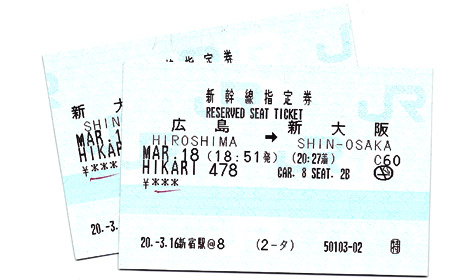 The especially helpful JR ticket clerk who booked our reserved Shinkansen tickets days earlier understood our requirements to leave and return on the same day. What this meant for us was catching the first and last trains of the day. The getting there portion of this worked flawlessly with time to spare, but included no train changes. The return trip, however, included one such change—giving us only six minutes to make our connection aboard the Hikari 434. We understood both trains would be near each other, but took no chances with the margin of error and were very prepared to depart the train when it pulled into Shin-Osaka Station.
We made the connection without issue and the rest of our trip back was uneventful, except for my sleepy mistaken impression we should exit the Odakyu train one station too early. We were close to home, but I was still very relieved to discover there was one last train that would take us from here to Odakyu-Sagamihara. Twenty-one hours and 210 pictures after starting this day, we were once again walking the darkened, mostly deserted streets of Sagamigaoka eagerly heading toward bed. Steven
The especially helpful JR ticket clerk who booked our reserved Shinkansen tickets days earlier understood our requirements to leave and return on the same day. What this meant for us was catching the first and last trains of the day. The getting there portion of this worked flawlessly with time to spare, but included no train changes. The return trip, however, included one such change—giving us only six minutes to make our connection aboard the Hikari 434. We understood both trains would be near each other, but took no chances with the margin of error and were very prepared to depart the train when it pulled into Shin-Osaka Station.
We made the connection without issue and the rest of our trip back was uneventful, except for my sleepy mistaken impression we should exit the Odakyu train one station too early. We were close to home, but I was still very relieved to discover there was one last train that would take us from here to Odakyu-Sagamihara. Twenty-one hours and 210 pictures after starting this day, we were once again walking the darkened, mostly deserted streets of Sagamigaoka eagerly heading toward bed. Steven  were anxious to hear about the day, but after a few quick highlights, I was on the floor mat drifting off to sleep, thinking about the hours past and days yet to come.
were anxious to hear about the day, but after a few quick highlights, I was on the floor mat drifting off to sleep, thinking about the hours past and days yet to come.
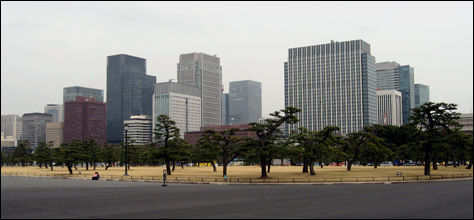 It was overcast and cool on the third day of my adventure, Monday, 17 March 2008. Walking down the street toward
It was overcast and cool on the third day of my adventure, Monday, 17 March 2008. Walking down the street toward  .
Making our way to
.
Making our way to  . By now, the trains were becoming less of a mystery and more of a tool, though there were some exceptions. While large and complex, the various interconnecting public transportation systems are relatively easy to navigate once you have an idea of how things work and where places are in relation to one another. Not to mention, signage in English and Japanese helps.
. By now, the trains were becoming less of a mystery and more of a tool, though there were some exceptions. While large and complex, the various interconnecting public transportation systems are relatively easy to navigate once you have an idea of how things work and where places are in relation to one another. Not to mention, signage in English and Japanese helps.
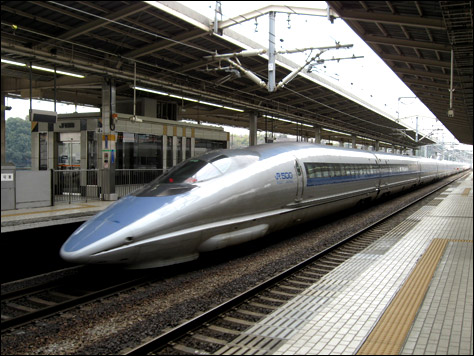 Not quite thirty minutes after boarding the Shinkansen, we were navigating the enormous Tokyo Station to the
Not quite thirty minutes after boarding the Shinkansen, we were navigating the enormous Tokyo Station to the  south exit. Unfortunately, the Marunouchi Gate
south exit. Unfortunately, the Marunouchi Gate  was undergoing renovations so scaffolding masked the brick structure built as the station's entrance in 1914. Continuing west from the station toward the Tokyo Imperial Palace on Gyoukou-dori Avenue
was undergoing renovations so scaffolding masked the brick structure built as the station's entrance in 1914. Continuing west from the station toward the Tokyo Imperial Palace on Gyoukou-dori Avenue  , the Marunouchi skyscrapers loomed ominously as we passed over the grids of crosswalks. Nearby structures of note include the
, the Marunouchi skyscrapers loomed ominously as we passed over the grids of crosswalks. Nearby structures of note include the  , the
, the  Headquarters Building, the
Headquarters Building, the  and the
and the  (Nihon Keizai Shimbun
(Nihon Keizai Shimbun  ) Headquarters.
Crossing Hibiya-dori Avenue
) Headquarters.
Crossing Hibiya-dori Avenue  , we leave the city behind and enter the Tokyo Imperial Palace grounds. The grounds exist as an oasis of sorts in the city, a large open green space surrounded on the perimeter by a moat and the skyscrapers beyond. After taking pictures around Babasaki-bori Moat
, we leave the city behind and enter the Tokyo Imperial Palace grounds. The grounds exist as an oasis of sorts in the city, a large open green space surrounded on the perimeter by a moat and the skyscrapers beyond. After taking pictures around Babasaki-bori Moat  and continuing through the plaza, we pass the Sakashita-mon Gate
and continuing through the plaza, we pass the Sakashita-mon Gate  on our way to the Nijubashi Bridge
on our way to the Nijubashi Bridge  , formerly a wooden structure known as Seimon-tetsubashi
, formerly a wooden structure known as Seimon-tetsubashi  .
.
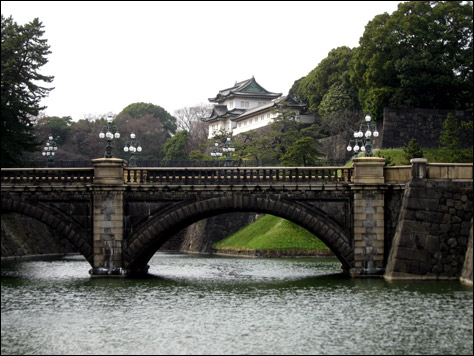 While walking through Tokyo Imperial Palace Square
While walking through Tokyo Imperial Palace Square  , a large unpaved street filled with rocks except for one small paved sidewalk, a police-escorted motorcade of vehicles emerged from the Main Gate
, a large unpaved street filled with rocks except for one small paved sidewalk, a police-escorted motorcade of vehicles emerged from the Main Gate  at Nijubashi Bridge. The cars were too far away to tell at the time, but a close inspection of my pictures shows the flag of Canada
at Nijubashi Bridge. The cars were too far away to tell at the time, but a close inspection of my pictures shows the flag of Canada  on the second of eight motorcade vehicles.
The next hour was spent walking the vast grounds, capturing images and enjoying the green space and architecture. Although it seemed large while walking around, considering we only saw a small portion of the land, the property once spanned the Marunouchi commercial district, including Tokyo Station and the surrounding landmarks within the outermost boundary (then the old moat).
on the second of eight motorcade vehicles.
The next hour was spent walking the vast grounds, capturing images and enjoying the green space and architecture. Although it seemed large while walking around, considering we only saw a small portion of the land, the property once spanned the Marunouchi commercial district, including Tokyo Station and the surrounding landmarks within the outermost boundary (then the old moat).
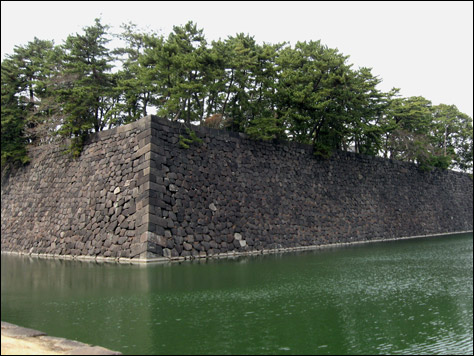 For over 550 years, this land has played an important part in Japanese government and military history. Around 1185, the transition from the
For over 550 years, this land has played an important part in Japanese government and military history. Around 1185, the transition from the  to the
to the  ,
,  warriors established a base in the area. In 1457,
warriors established a base in the area. In 1457,  built the
built the  . After rising to power,
. After rising to power,  established a government and took the Edo Castle as his own. The
established a government and took the Edo Castle as his own. The  would hold power from the castle for the duration of the
would hold power from the castle for the duration of the  , 1603–1868, until the
, 1603–1868, until the  .
.
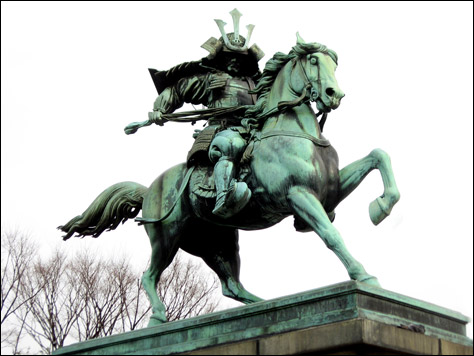 After an accidental fire destroyed the last remaining structures of Edo Castle in 1873, a new Imperial Palace Kyujo
After an accidental fire destroyed the last remaining structures of Edo Castle in 1873, a new Imperial Palace Kyujo  was constructed for
was constructed for  . This facility was ultimately destroyed in
. This facility was ultimately destroyed in  and rebuilt in 1948 as Kokyo
and rebuilt in 1948 as Kokyo  in 1986 and remains open to the public today. We did not make it over to Higashi-Gyoen, but we did visit the Sakuradamon Gate
in 1986 and remains open to the public today. We did not make it over to Higashi-Gyoen, but we did visit the Sakuradamon Gate  and the Statue of
and the Statue of  before descending into
before descending into  .
.
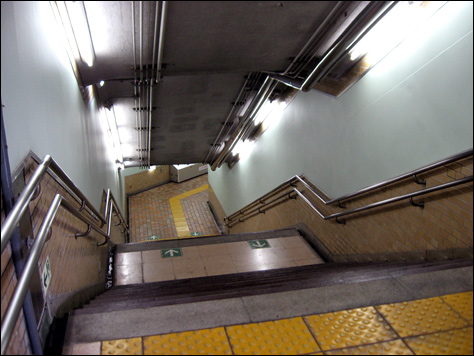 A short subway ride later, we passed the gate into the Tokyo Metropolitan Central Wholesale Market commonly known as the
A short subway ride later, we passed the gate into the Tokyo Metropolitan Central Wholesale Market commonly known as the  , the largest wholesale fish and seafood market in the world. The Tsukiji Market opened in 1935 after the former
, the largest wholesale fish and seafood market in the world. The Tsukiji Market opened in 1935 after the former  fish market was destroyed in the
fish market was destroyed in the  of 1923.
of 1923.
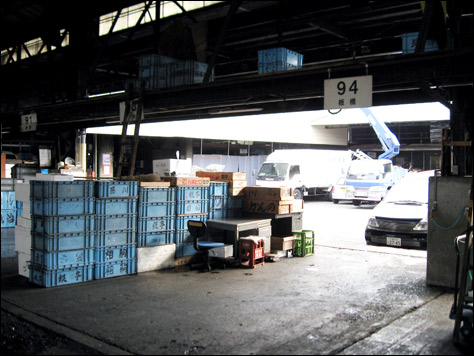 Since it was 1530 JST, the inner market was deserted and quiet. Our original plan was to visit during peak hours (0700–1000) but with limited time available and a daylong trip to the other side of the country scheduled for the next day, this venture was sacrificed. Although it was empty, you could get a feel for how it must be when busy. Building after building contained long rows with numbered stalls for the "middlemen" to display and sell the products not sold at the earlier auction (0530–0700). Even though there were no fish visible, the smell of piscine permeated the air.
Since it was 1530 JST, the inner market was deserted and quiet. Our original plan was to visit during peak hours (0700–1000) but with limited time available and a daylong trip to the other side of the country scheduled for the next day, this venture was sacrificed. Although it was empty, you could get a feel for how it must be when busy. Building after building contained long rows with numbered stalls for the "middlemen" to display and sell the products not sold at the earlier auction (0530–0700). Even though there were no fish visible, the smell of piscine permeated the air.
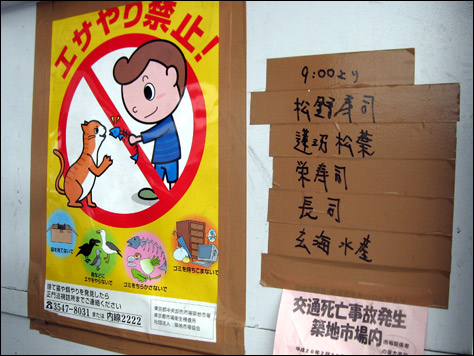 Moving into the outer market, it was still quiet but evidence of life was just an alley away. Most of the seafood and cooking/restaurant supply shops were closed due to the time, but many sushi restaurants were open and doing business. I was not yet hungry, so I did not eat at the restaurant with horse flesh on the menu or at the eatery a few doors down with a sushi conveyor belt. Passing more shops, numerous small shrines—which are scattered everywhere in Japan as far as I can tell—and a Tsukiji kitty cat, no doubt well fed given his or her home, we made our way past the
Moving into the outer market, it was still quiet but evidence of life was just an alley away. Most of the seafood and cooking/restaurant supply shops were closed due to the time, but many sushi restaurants were open and doing business. I was not yet hungry, so I did not eat at the restaurant with horse flesh on the menu or at the eatery a few doors down with a sushi conveyor belt. Passing more shops, numerous small shrines—which are scattered everywhere in Japan as far as I can tell—and a Tsukiji kitty cat, no doubt well fed given his or her home, we made our way past the  to
to  where the
where the  would take us directly to our next destination,
would take us directly to our next destination,  .
.
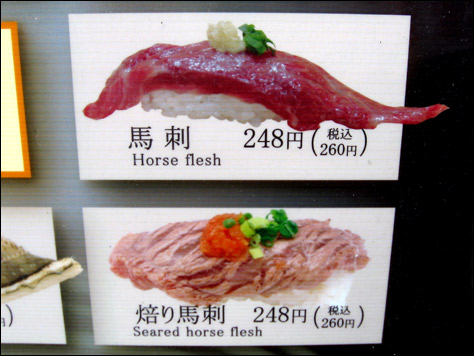 Located in the
Located in the  , Ginza is an upscale shopping district with many large department stores, restaurants and expensive Western boutiques. After exiting the train at
, Ginza is an upscale shopping district with many large department stores, restaurants and expensive Western boutiques. After exiting the train at  , we navigated the underground maze of tunnels, themselves an extensive shopping and dining area. Just as I was about to commit our route (in the wrong direction), Mom saw the sign for which we were looking. The lift doors opened and we walked out into the lobby of the
, we navigated the underground maze of tunnels, themselves an extensive shopping and dining area. Just as I was about to commit our route (in the wrong direction), Mom saw the sign for which we were looking. The lift doors opened and we walked out into the lobby of the  .
.
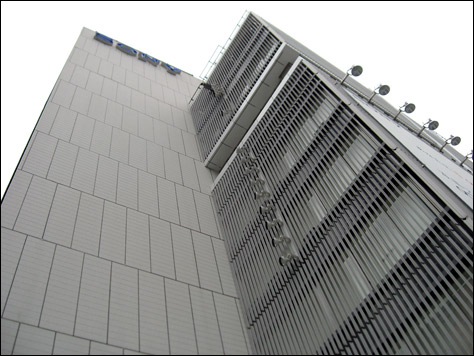 The
The  is filled with fully functional telephones, cameras, computers and other gadgets. Walking up and around the spiral showroom looking at the neat hardware, some of which is not available in the United States, I stopped to use a
is filled with fully functional telephones, cameras, computers and other gadgets. Walking up and around the spiral showroom looking at the neat hardware, some of which is not available in the United States, I stopped to use a  notebook to e-mail friends at home. The operating system was
notebook to e-mail friends at home. The operating system was  but the language Japanese, so it is a good thing I know my way around a computer. It was all for not though as the Sony firewall blocked my access to webmail.
Before exiting the Sony Building to explore Ginza, I noticed a sign indicating all Sony Showroom facilities are powered exclusively by wind energy. In fact, there was a certificate from the
but the language Japanese, so it is a good thing I know my way around a computer. It was all for not though as the Sony firewall blocked my access to webmail.
Before exiting the Sony Building to explore Ginza, I noticed a sign indicating all Sony Showroom facilities are powered exclusively by wind energy. In fact, there was a certificate from the  and the
and the  attesting to the generation of 145,000 kWh at the Choshi Byoubugaura
attesting to the generation of 145,000 kWh at the Choshi Byoubugaura  Wind Power Station for use at the Ginza Sony Showroom.
Wind Power Station for use at the Ginza Sony Showroom.
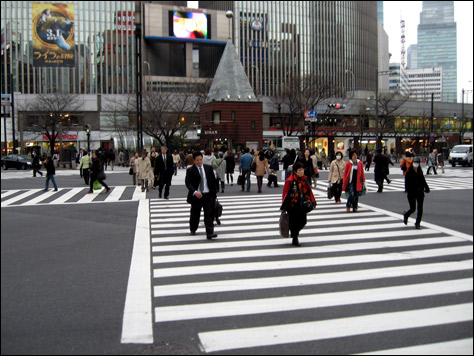 Upon leaving the Sony Building, the skyscrapers of Ginza tower overhead while the vast crosswalk grid of the Sukiyabashi Intersection
Upon leaving the Sony Building, the skyscrapers of Ginza tower overhead while the vast crosswalk grid of the Sukiyabashi Intersection  sprawls in front of you. Huge lit signs advertising
sprawls in front of you. Huge lit signs advertising  ,
,  ,
,  ,
,  and more flash and glow from high above. There is a palatable energy in the air as scores of people move in and between buildings, cars whiz past but obey pedestrian road rules and trains rumble by on overhead tracks. The area is slightly reminiscent of New York City's
and more flash and glow from high above. There is a palatable energy in the air as scores of people move in and between buildings, cars whiz past but obey pedestrian road rules and trains rumble by on overhead tracks. The area is slightly reminiscent of New York City's  ritzy Fifth Avenue shopping district, but completely distinctive itself and uniquely Japanese.
ritzy Fifth Avenue shopping district, but completely distinctive itself and uniquely Japanese.
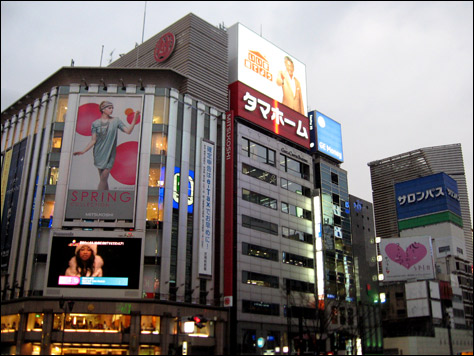 Although we were walking around, stopping as we pleased to look inside stores and taking a short break in a little park with fountains, we were in fact looking for the
Although we were walking around, stopping as we pleased to look inside stores and taking a short break in a little park with fountains, we were in fact looking for the  department store. Mom had read about this and other Japanese department stores and wanted to look inside one. We eventually found Mitsukoshi and went inside. Floor after floor was filled with merchandise, lots of customers and attentive hosts and clerks standing by to assist. We made our way through the store to the food market levels, reportedly modeled after similar markets in
department store. Mom had read about this and other Japanese department stores and wanted to look inside one. We eventually found Mitsukoshi and went inside. Floor after floor was filled with merchandise, lots of customers and attentive hosts and clerks standing by to assist. We made our way through the store to the food market levels, reportedly modeled after similar markets in  department store in London
department store in London  . Although I have been to Harrods, the experience also reminded me of visting
. Although I have been to Harrods, the experience also reminded me of visting  in Buffalo
in Buffalo  in the 1980s.
By now, it was around 1800 JST and I was ready to eat. We proceeded to the basement, where restaurants are known to be located in Japanese department stores. After inspecting the plastic food models in the window display, we entered the
in the 1980s.
By now, it was around 1800 JST and I was ready to eat. We proceeded to the basement, where restaurants are known to be located in Japanese department stores. After inspecting the plastic food models in the window display, we entered the  restaurant for dinner. Mom had eaten earlier so she had a drink and dessert—one of the best tasting vanilla ice creams she has tasted—and I ordered cold Sake
restaurant for dinner. Mom had eaten earlier so she had a drink and dessert—one of the best tasting vanilla ice creams she has tasted—and I ordered cold Sake  and the Nigiri Sushi (Hana)
and the Nigiri Sushi (Hana)  platter. Like many other locals we interacted with, the waiter knew some English and was pleased to use it with us. The food and drink were delicious, but I particularly enjoyed the wasabi
platter. Like many other locals we interacted with, the waiter knew some English and was pleased to use it with us. The food and drink were delicious, but I particularly enjoyed the wasabi  that seemed much hotter than any I have had before.
that seemed much hotter than any I have had before.
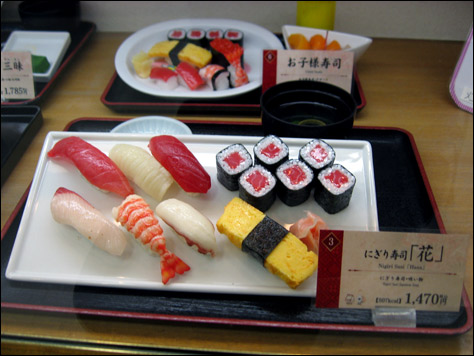 After dinner, it was time to head back to the apartment. I grabbed a few last pictures on the train platform, bringing the day's count to 262. We needed to get to sleep despite the early time of 1900, for the next day's journey would require getting up and leaving by 0400 in order to make all the necessary train connections.
The destination is
After dinner, it was time to head back to the apartment. I grabbed a few last pictures on the train platform, bringing the day's count to 262. We needed to get to sleep despite the early time of 1900, for the next day's journey would require getting up and leaving by 0400 in order to make all the necessary train connections.
The destination is